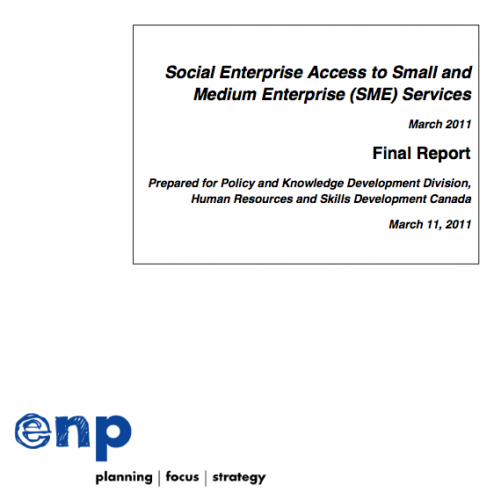The research on social enterprise (SE) access to Federal, Provincial, and Territorial funded (F/P/T) small and medium enterprise (SME) services was completed in response to a request by Human Resources and Skills Development Canada (HRSDC). The research conducted a review of 100 F/P/T SME programs and services and interviews with 17 key stakeholder informants.
The research findings and proposed recommendations intend to provide evidence of current gaps and barriers and suggestions for strategic steps in the creation of improved, accessible SME services for social enterprises.
In the research, three major categories of SE access to existing SME services emerged.
- 5% of the sample states in its purpose or eligibility requirements a clear access for SE.
- In 93% of the sample, ambiguity and confusion issues emerged. 55% of the total reviewed indicate that they are open to non-profits, but do not clarify how that relates to social enterprise. 38% of programs and services do not identify non-profits (or, therefore, SE) in their program description or eligibility criteria. The barriers created when SME services neglect to include details regarding nonprofit and SE eligibility significantly restrict access. In these cases of “neglect and omission”, it is questionable whether the service may or may not be accessible to non-profits and SEs.
- 2% of programs and services reviewed are identified as specifically excluding non-profits. Although this represents a relatively small percentage of the total reviewed, the number would likely increase if the services with unclear or vague eligibility descriptions were clarified.
Surveys and interviews confirmed a critical concern: the inaccessibility to SME services for social enterprises are in a few cases real, but in most cases access is unclear, ambiguous, or perceived as inaccessible.
Recommendations:
- Lessons must be taken from programs and services that support SE and their process and regulatory support replicated.
- Unclear services must clarify the definition of “non-profit” and eligibility requirements.
- SME services that have neglected non-profits in descriptions and requirements must define requirements and regulations with more detail, explicitly including social enterprises.
- In cases of denied access, changes must be made to eliminate exclusionary practices and regulations.
A further gap for social enterprises emerged: existing SME services are not aligned with the structural elements of social enterprises that operate in a non-profit or charitable structure and are focused on creating a ‘blended’ return on investment, both financial and social.
Recommendation:
Enhance and adjust existing programs and develop new service-specific offerings to meet the unique needs of social enterprises’ blended value and non-share, non-profit structures. Making adjustments and clarifying access to the existing SME programs and filling service gaps will address key business development needs for social enterprise and strengthen social enterprises across Canada.
Read the Social Enterprise Access to Small and Medium Enterprise (SME) Services report
Table of Contents
Acknowledgements
1.0 Introduction
1.1 Research Problem
2.0 Research Design & Methodology
2.1 Interview Sample Design
2.2 Focus Group of Key Informants
2.3 Secondary Research
2.4 Limitations of this Study
3.0 Research Findings
Exhibit A: Summary of SME Programs and Services Reviewed
3.1 SUPPORT: SME services that support social enterprise
3.1.1 Program Examples
3.1.2 Interview Comments
3.2 UNCLEAR: SME services that are open to non-profits but unclear regarding SE
3.2.1 Program Examples
3.2.2 Interview Comments
3.3 NEGLECT: SME services that do not identify non-profits
3.3.1 Program Examples
3.3.2 Interview Comments
3.3.3 Case Study: BDC
3.4 DENY: SME services that deny access to non-profits
3.4.1 Program Examples
3.4.2 Interview Comments
3.4.3 Case Study: Peace Region Internet Society
4.0 Analysis of SME Service Gaps and Social Enterprise Needs Gaps
4.1 Access to Existing SME Services Gap Analysis
Exhibit B: Graph depicting SME service gaps for SE based on service type & accessibility
4.2 Social Enterprise Needs Gap
5.0 Recommendations
5.1 Remove Real and Perceived Barriers to Existing Programs
Exhibit C: Access to Existing SME Programs Summary of Recommendations
5.2 Respond to Specific Needs of Social Enterprises
6.0 Conclusion
7.0 Appendices
Appendix A: Social Enterprise Support Matrix Examples
Appendix B: Interview Databases
Appendix C: Interview Response Summaries
Appendix D: Labour Market Partnership Advisory Council Membership List
Appendix E: Research Spreadsheet
Appendix F: Access to SME Services Research Overview
Appendix G: BDC Case Study
Appendix H: Peace Region Internet Society Case Study





